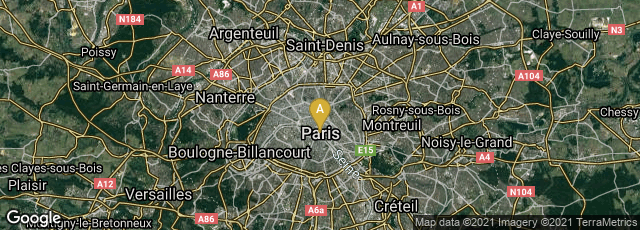

A: Paris, Île-de-France, France
The Bedford Hours, (British Library Add MS 18850) a late medieval book of hours, was probably produced in Paris for John, Duke of Bedford to celebrate his marriage to Anne, daughter of Philip the Bold, Duke of Burgundy. Production was was in several stages from about 1410 to about 1430, with new material added as the manuscript passed from owner to owner. Some of its miniatures have been attributed to the Bedford Master (possibly Haincelin of Hagenau, who was working in Paris at the time), or to the Chief Associate of the Bedford Master, or simply to the "Bedford Workshop".
The work of the Bedford Master and the Bedford Workshop have been identified in other manuscripts from the period, including the Salisbury Breviary (Bibliothèque nationale de France MS.lat. 17294), also owned by the Duke of Bedford. The style and quality of the illumination in the Bedford Hours is also related to that in the Très Riches Heures du Duc de Berry illuminated by the Limbourg brothers. It is also possible that some of the miniatures in the Bedford Hours were based on images in the Très Riches Heures.
"The origins of the manuscript are not known with certainty, nor is there agreement on its initial patron. The inclusion of certain heraldic symbols in its decorative programme may suggest an original patronage in the French royal family, perhaps the dauphin, Louis of Guyenne (d. 1415). Or this first stage in production might have taken place later, after Louis's death, the heraldic symbols having no immediate reference to patronage, but simply being part of the standard iconographic programme of the workshop.
"In the early 1420s the manuscript was in the possession of John of Lancaster, the Duke of Bedford and regent of France on behalf of his nephew Henry VI from 1422 until his death in 1435. In 1423, he gave the manuscript to his wife Anne of Burgundy as a wedding present. Personalizing additions to the manuscript's illumination that commemorate its ownership by the Duke and Duchess of Bedford include two large portrait miniatures (ff. 256v and 257v), showing John kneeling before St George and Anne of Burgundy kneeling before St Anne.
"In 1430 Anne gave the manuscript as a Christmas present to the nine-year-old Henry VI, who was staying with the Bedfords in Rouen before his coronation as king of France. This gift was memorialized in the manuscript itself, on f. 256r, in an inscription made at the duke's request, written by John Somerset, Henry's tutor and personal physician. It is possible that it was in preparing the book as a gift to Henry that the portrait miniatures of the Bedfords were added, along with other additions to the programme of illumination.
"Later owners include King Henry II of France and his wife Catherine de' Medici (identifiable by their coats of arms, added to the manuscript), and Frances Worsley (1673-1750), wife of Sir Robert Worsley, 4th baronet of Appuldurcombe. Edward Harley probably purchased the manuscript from Frances Worsley, but he did not will it to his widow with the rest of the Harley collection, instead bequeathing it directly to his daughter, Margaret Bentinck, Duchess of Portland...." (Wikipedia article on Bedford Hours, accessed 11-07-2013).
After the death of the Duchess of Portland, on May 24, 1786 the English bookseller James Edwards purchased the Bedford Hours for £213.3s. at the sale of her collections. Edwards commissioned the antiquarian and writer Richard Gough to prepare a monograph on the manuscript. This work entitled An Account of a Rich Illuminated Missal Executed for John Duke of Bedford, Regent of France under Henry VI, and afterwards in the Possession of the Late Duchess of Portland, was printed by John Nichols and published by T. Payne in London in 1794. A work of 86 pages in quarto format, with 4 black and white engraved plates depicting full-page illuminations in the manuscript, this was the first monograph on an illuminated manuscript published in English, and may be considered the beginning of English scholarship on illuminated manuscripts. Most of its text was devoted to explaining details in each of the 59 full-page miniatures, and discussing details of its prior owners. My copy, which bears the bookplate of the Bibliotheca Lindesiana, contains pencil notes on p. 82 tracing later owners of the copy from which I quote:
"Subsequently belonged to the 5th Duke of Marlbourgh (£687.15.0). John Milner (£800) & Sir John Tobin of Liverpool (£1250), & in Jan. 1852 it was sold by the Rev. John Tobin, son of the last-named, with five other MSS to the bookseller William Boone, who ... transferred all six MSS... to the British Museum for £3000 (2 Feb. 1852)."
The Bedford Hours is preserved in the British Library (Add. MS 18850). In February 2014 a digital facsimile of all aspects of the manuscript was available at this link.
Backhouse, "A Reappraisal of the Bedford Hours" (1981).